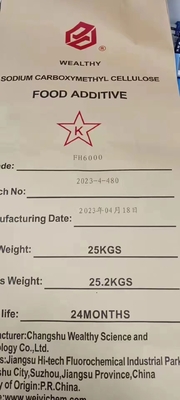CMC 25kg Food Grade E466 Thickener Powder CAS 9004-32-4

Contact me for free samples and coupons.
WhatsApp:0086 18588475571
Wechat: 0086 18588475571
Skype: sales10@aixton.com
If you have any concern, we provide 24-hour online help.
x| Color | White | Appearance | Light And Free Flowing Powder |
|---|---|---|---|
| Qty In 20' FCL | 16MT | CAS No | 9000-11-7 |
| Type | Thickeners | CMC | Application Of CMC In Washing |
| High Light | Food Grade E466 Thickener Powder,CMC E466 Thickener Powder,CAS 9004-32-4 Chemical Food Ingredients |
||
CMC
We provide the WEIYI, YULONG brand Sodium Carboxymethyl Cellulose (CMC) can be use in juice and beverage products.
![]()
Application of CMC
Thickening, dispersing and emulsifying effect
High degree of substitution and fine transparency performance
Fine dispersing performance in water
High viscosity and fine stability
Models: 8000S etc.
Carboxy methyl cellulose (CMC) or cellulose gum is a cellulose derivative with carboxymethyl groups (-CH2-COOH) bound to some of the hydroxyl groups of the glucopyranose monomers that make up the cellulose backbone. It is often used as its sodium salt, sodium carboxymethyl cellulose.
It is synthesized by the alkali-catalyzed reaction of cellulose with chloroacetic acid. The polar (organic acid) carboxyl groups render the cellulose soluble and chemically reactive. The functional properties of CMC depend on the degree of substitution of the cellulose structure (i.e., how many of the hydroxyl groups have taken part in the substitution reaction), as well as the chain length of the cellulose backbone structure and the degree of clustering of the carboxymethyl substituents.
UsesCMC is used in food science as a viscosity modifier or thickener, and to stabilize emulsions in various products including ice cream. As a food additive, it has E number E466. It is also a constituent of many non-food products, such as K-Y Jelly, toothpaste, laxatives, diet pills, water-based paints, detergents, textile sizing and various paper products. It is used primarily because it has high viscosity, is non-toxic, and is hypoallergenic. In laundry detergents it is used as a soil suspension polymer designed to deposit onto cotton and other cellulosic fabrics creating a negatively charged barrier to soils in the wash solution. CMC is used as a lubricant in non-volatile eye drops (artificial tears). Sometimes it is methyl cellulose (MC) which is used, but its non-polar methyl groups (-CH3) do not add any solubility or chemical reactivity to the base cellulose.
Following the initial reaction the resultant mixture produces approximately 60% CMC plus 40% salts (sodium chloride and sodium glycolate). This product is the so-called Technical CMC which is used in detergents. A further purification process is used to remove these salts to produce pure CMC which is used for food, pharmaceutical and dentifrice (toothpaste) applications. An intermediate "semi-purified" grade is also produced, typically used in paper applications.

















